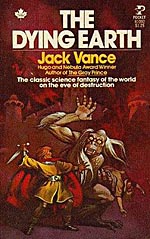
![]() Scott Laz
Scott Laz
7/22/2012
![]()
The work of Grand Master Jack Vance can be segmented into science fiction and fantasy (actually, he wrote some mysteries, too), but they all straddle the borderline between the two genres. Both his fantasy, beginning with The Dying Earth (1950), and his science fiction, beginning with Big Planet (1952), can be seen as the earliest of the modern "planetary romances" – stories set on alien worlds, with plots involving exploration of the sociological and anthropological aspects of these worlds. An important precursor is Clark Ashton Smith, whose tales were often set in far future settings where "technology is indistinguishable from magic," to borrow Arthur C. Clarke's maxim. Leigh Brackett's stories of Mars and Venus, in turn influenced by Edgar Rice Burroughs, are also important early examples. These stories are not hard science fiction – the nature of the technology is not a focus of the stories, and there are no technological problems to understand or solve. But they are not pure fantasy either, since they are set on alien worlds or in the far future of Earth, and may include the trappings of SF such as spaceships and aliens.
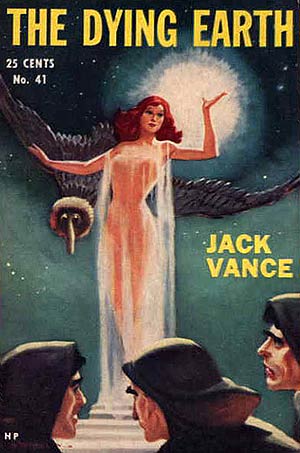 The Dying Earth is generally classified as fantasy, being set on a world where magicians wield spells and fantastic creatures abound. But the actual setting is the far future of Earth – so far in the future that the few people still alive are well aware that their sun is dying, and their planet may reach its end at any time. In this world, we encounter creatures such as twk-men, who ride dragonflies and trade information for salt, and dangerous humanoids like the deodands and gauns. This certainly reads like fantasy, but who knows what sort of life may evolve (or be engineered) on Earth over the next few billion years? Given the rate of evolution thus far, the surprise is not that new forms of life would exist on Earth in the age when the sun is dying, but rather that people recognizable as humanity would still be around.
The Dying Earth is generally classified as fantasy, being set on a world where magicians wield spells and fantastic creatures abound. But the actual setting is the far future of Earth – so far in the future that the few people still alive are well aware that their sun is dying, and their planet may reach its end at any time. In this world, we encounter creatures such as twk-men, who ride dragonflies and trade information for salt, and dangerous humanoids like the deodands and gauns. This certainly reads like fantasy, but who knows what sort of life may evolve (or be engineered) on Earth over the next few billion years? Given the rate of evolution thus far, the surprise is not that new forms of life would exist on Earth in the age when the sun is dying, but rather that people recognizable as humanity would still be around.
As for the magic, it seems to have supplanted technology at some point far in the past, but the age of magic has also receded into the past. Just as with the strange creatures, a science fictional explanation can be inferred, but is not explicitly presented. Vance gives us only the point of view of his characters. There is no omniscient narrator to fill us in, and the past history of these events has taken on the character of legends:
"At one time a thousand or more runes, spells, incantations, curses, and sorceries had been known... A hundred spells Phandaal personally had formulated... Pontecilla the Pious, then ruler of Grand Motholam, put Phandaal to torment, and after a terrible night, he killed Phandaal and outlawed sorcery throughout the land. The wizards of Grand Motholam fled like beetles under a strong light; the lore was dispersed and forgotten, until now, at this dim time, with the sun dark, wilderness obscuring Ascolais, and the white city Kalin half in ruins, only a few more than a hundred spells remained to the knowledge of man. Of these, Mazirian had access to seventy-three, and gradually, by stratagem and negotiation, was securing the others."
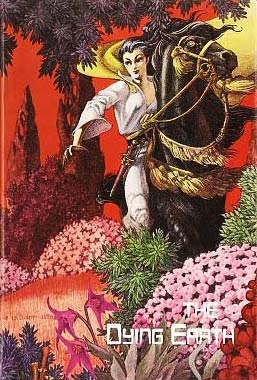 It is no longer widely known, even among magicians, that their spells are based on "a strange abstract lore... termed 'Mathematics'... Within this instrument... resides the Universe... Your spells and runes are built upon its power and codified according to a great underlying mosaic... Phandaal glimpsed the pattern and so was able to formulate many of the spells..." Magicians like Mazirian, the protagonist of the first of the six linked stories that make up The Dying Earth, no longer understand the basis of their spells, instead learning them by rote. They can only hold a few in their head at once, after which they are forgotten and must be relearned. Spells such as the Excellent Prismatic Spray – hundreds of streaking colored lights that become solid and penetrate like needles; the Spell of the Slow Hour; Phandaal's Mantle of Stealth; and the Call to the Violent Cloud:
It is no longer widely known, even among magicians, that their spells are based on "a strange abstract lore... termed 'Mathematics'... Within this instrument... resides the Universe... Your spells and runes are built upon its power and codified according to a great underlying mosaic... Phandaal glimpsed the pattern and so was able to formulate many of the spells..." Magicians like Mazirian, the protagonist of the first of the six linked stories that make up The Dying Earth, no longer understand the basis of their spells, instead learning them by rote. They can only hold a few in their head at once, after which they are forgotten and must be relearned. Spells such as the Excellent Prismatic Spray – hundreds of streaking colored lights that become solid and penetrate like needles; the Spell of the Slow Hour; Phandaal's Mantle of Stealth; and the Call to the Violent Cloud:
"All was quiet; then came a whisper of movement swelling to the roar of great winds. A wisp of white appeared and waxed to a pillar of boiling black smoke... The cloud whirled down; far up and away he was snatched, flung head over heels into incalculable distance. Four directions was he thrust, then one, and at last a great blow hurled him from the cloud, sprawled him onto Embelyon."
In reviewing anything by Vance, it's difficult to resist quoting multiple passages in order to give a sense of his unique and wonderful writing style. "Colorful" is the word that always comes to mind (some of the descriptions seem downright psychedelic); I've also often heard "lyrical" applied in describing it. Full of evocative descriptions that are just "off" enough to maintain a sense of alienness, they often make use of archaic or invented words that seem to have just the right feel. This facility with odd terminology extends to Vance's well-known facility for inventing names for people and places, as evidenced in the quotes above, which help create a sense of place and history in the worlds he builds. Vance was a world traveler throughout his life and wrote his earliest stories – including The Dying Earth – while in the Merchant Marine, and his exposure to multiple cultures must have strongly informed his writing both in terms of his ability to elucidate alien worlds and the language he used to describe them.
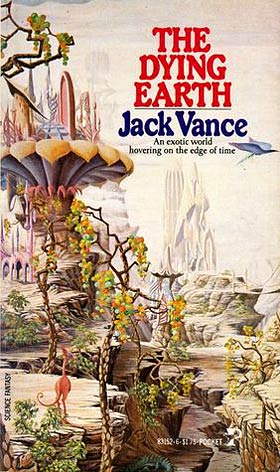 The Dying Earth is also notable for its structure. Though generally thought of as a novel, the book's six stories do not make up a continuous narrative, but rather, by way of their variety, paint the picture of the larger setting in which they all occur. I think the stories can be grouped thematically in three pairs, but there are certainly other ways to interpret Vance's organization of them. In the first pair, we learn about the nature of magic and the strange amoral character of the magicians who seek to add to their power and best their rivals. In "Mazirian the Magician", the titular character has captured his rival Turjan, whom he miniaturizes and traps in a box with a miniature dragon that Turjan must continually evade. Through this torture, Mazirian hopes to extort Turjan's secret for imbuing artificial life ("vat creatures") with human intelligence. At the same time, Mazirian is being tormented by a mysterious and beguiling horsewoman, who repeatedly trespasses on his land, appearing but always retreating before she can be confronted. Determined to talk to her, Mazirian finally sets off in pursuit, at which point the story's point of view shifts to the woman – T'sain, whom we learn is one of Turjan's intelligent creations, tasked by the magician to lure Mazirian to his death and come to his rescue. The next story, "Turjan of Mir", goes back in time (somewhat disorientingly, at first) to tell the story of how Turjan learned the secrets Mazirian tried to steal from him, and created T'Sain.
The Dying Earth is also notable for its structure. Though generally thought of as a novel, the book's six stories do not make up a continuous narrative, but rather, by way of their variety, paint the picture of the larger setting in which they all occur. I think the stories can be grouped thematically in three pairs, but there are certainly other ways to interpret Vance's organization of them. In the first pair, we learn about the nature of magic and the strange amoral character of the magicians who seek to add to their power and best their rivals. In "Mazirian the Magician", the titular character has captured his rival Turjan, whom he miniaturizes and traps in a box with a miniature dragon that Turjan must continually evade. Through this torture, Mazirian hopes to extort Turjan's secret for imbuing artificial life ("vat creatures") with human intelligence. At the same time, Mazirian is being tormented by a mysterious and beguiling horsewoman, who repeatedly trespasses on his land, appearing but always retreating before she can be confronted. Determined to talk to her, Mazirian finally sets off in pursuit, at which point the story's point of view shifts to the woman – T'sain, whom we learn is one of Turjan's intelligent creations, tasked by the magician to lure Mazirian to his death and come to his rescue. The next story, "Turjan of Mir", goes back in time (somewhat disorientingly, at first) to tell the story of how Turjan learned the secrets Mazirian tried to steal from him, and created T'Sain.
The next pair of stories, "T'Sais" and "Liane the Wayfarer", further exposes the darkness underlying the dying earth. T'Sain was Turjan's attempt to correct the mistake of his teacher, Pandelume, whose own creation, T'Sais, was flawed. T'Sais could only see the darkness and ugliness of the world, but is convinced by T'Sain to travel from Pandelume's magical domain to Earth, in search of beauty. But T'Sain at first finds a world that really is dark and ugly, where she is preyed upon by evil men and strange violent creatures, before she is befriended by Etarr, another victim of dark magic. T'Sain does find beauty, but not in the way she had expected. Meanwhile, one of her tormenters, Liane, seemingly killed in the third story, is alive again in the fourth, so he can be perish once more at the hands of "Chun the Unavoidable", who lives up to his title. Liane – thief, murderer, rapist – seems to represent the rampant amorality that characterizes the dying world, as social values takes on a different guise in a place where there may be nothing to live for in the long run.
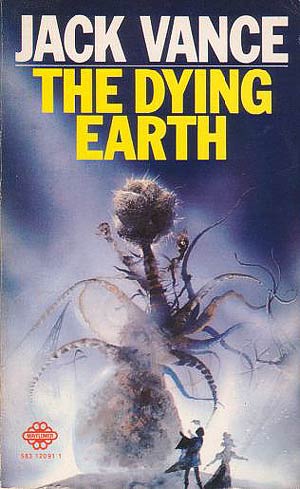 Another characteristic of this world is a declining interest in achieving knowledge or progress. We have already learned that magic replaced technology, before in turn being mostly forgotten. In "Ulan Dhor Ends a Dream", we travel to Ampridatvir, which seems to be the crowning achievement of human civilization, and learn of its decline. With all technological problems solved, it turns out that "a surfeit of ease guts a man of strength. Light, warmth, food, water, were free to all men, and gained by a minimum of effort. So the people of Ampridatvir, released from toil, gave increasing attention to faddishness, perversity, and the occult." Ulan Dhor travels to Ampridatvir to learn its ancient secrets, a decision that puts him at odds with the prevailing lassitude of Earth's final days. Similarly, in the final story, the titular "Guyal of Sfere" is hungry for knowledge – a "source of vexation for his sire", who ultimately allows Guyal, whom his father now considers "past the verge of madness" because of his insistence on asking questions about the world, to travel to Ascolais so that he can have his questions answered by the Curator of the Museum of Man. Like Ulan's in the previous story, Guyal's adventures further illuminate the dying earth, and provide a glimmer of hope in this fallen world.
Another characteristic of this world is a declining interest in achieving knowledge or progress. We have already learned that magic replaced technology, before in turn being mostly forgotten. In "Ulan Dhor Ends a Dream", we travel to Ampridatvir, which seems to be the crowning achievement of human civilization, and learn of its decline. With all technological problems solved, it turns out that "a surfeit of ease guts a man of strength. Light, warmth, food, water, were free to all men, and gained by a minimum of effort. So the people of Ampridatvir, released from toil, gave increasing attention to faddishness, perversity, and the occult." Ulan Dhor travels to Ampridatvir to learn its ancient secrets, a decision that puts him at odds with the prevailing lassitude of Earth's final days. Similarly, in the final story, the titular "Guyal of Sfere" is hungry for knowledge – a "source of vexation for his sire", who ultimately allows Guyal, whom his father now considers "past the verge of madness" because of his insistence on asking questions about the world, to travel to Ascolais so that he can have his questions answered by the Curator of the Museum of Man. Like Ulan's in the previous story, Guyal's adventures further illuminate the dying earth, and provide a glimmer of hope in this fallen world.
The Dying Earth is one of those few works that lent its title to a particular type of story – "A not uncommon category of sf story which has now developed its own melancholy mythology. Since the Sun is invariably moribund if not extinguished, this could also be called the dying-sun theme..." (from The Encyclopedia of Science Fiction). The best-known variation on the dying earth theme is Gene Wolfe's The Book of the New Sun, and the Encyclopedia also mentions Paul Park's Starbridge Chronicles. In 2009, a tribute anthology edited by George R. R. Martin and Gardner Dozois, Songs of the Dying Earth, allowed nearly two dozen authors (Silverberg, Gaiman, Resnick, Cook...) to pay tribute to Vance and his creation, indicating the influence it has had on speculative fiction.
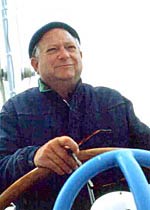 The Dying Earth was written in the 1940s, rejected by the science fiction magazines, and finally published as a book collection in 1950, but did not reach a large audience until reprinted in the '60s, steadily gaining in reputation through the years. Vance himself published three more books in the same setting – one novel, The Eyes of the Overworld, 1966) and two more linked collections, Cugel's Saga, 1983, and Rhialto the Marvellous, 1984 – though none quite reach the heights of the original. As a side note, all of Vance's works are just now being made available at Vance's official website (as well as the usual retailers), in nicely formatted ebooks based on the Vance Integral Edition texts, with Vance's preferred texts and titles. (Oddly, the title of The Dying Earth has been changed to Mazirian the Magician for this edition.) In another indication of Vance's influence and legacy, the Integral Edition is a set of definitive texts of the author's works, prepared with his cooperation by a group of fan volunteers dedicated to seeing his works in print in the best possible form. The treatment is well deserved, and the dedication of these fans is understandable. For those who haven't yet tried the work of Jack Vance, The Dying Earth is the place to start. If you're like me, you're unlikely to stop...
The Dying Earth was written in the 1940s, rejected by the science fiction magazines, and finally published as a book collection in 1950, but did not reach a large audience until reprinted in the '60s, steadily gaining in reputation through the years. Vance himself published three more books in the same setting – one novel, The Eyes of the Overworld, 1966) and two more linked collections, Cugel's Saga, 1983, and Rhialto the Marvellous, 1984 – though none quite reach the heights of the original. As a side note, all of Vance's works are just now being made available at Vance's official website (as well as the usual retailers), in nicely formatted ebooks based on the Vance Integral Edition texts, with Vance's preferred texts and titles. (Oddly, the title of The Dying Earth has been changed to Mazirian the Magician for this edition.) In another indication of Vance's influence and legacy, the Integral Edition is a set of definitive texts of the author's works, prepared with his cooperation by a group of fan volunteers dedicated to seeing his works in print in the best possible form. The treatment is well deserved, and the dedication of these fans is understandable. For those who haven't yet tried the work of Jack Vance, The Dying Earth is the place to start. If you're like me, you're unlikely to stop...